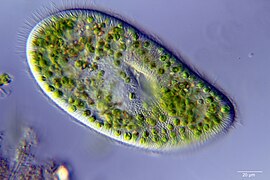Paramecium bursaria is a species of ciliate found in marine and brackish waters.[1] It has a mutualistic endosymbiotic relationship with green algae called Zoochlorella. About 700 Chlorella cells live inside the protist's cytoplasm and provide it with food, while the Paramecium provides the algae with movement and protection.[2] P. bursaria is 80-150 μm long, with a wide oral groove, two contractile vacuoles, and a single micronucleus as well as a single macronucleus. P. bursaria is the only species of Paramecium that forms symbiotic relationships with algae, and it is often used in biology classrooms both as an example of a protozoan and also as an example of symbiosis.
| Paramecium bursaria | |
|---|---|

| |
| Scientific classification | |
| Domain: | Eukaryota |
| Clade: | Diaphoretickes |
| Clade: | SAR |
| Clade: | Alveolata |
| Phylum: | Ciliophora |
| Class: | Oligohymenophorea |
| Order: | Peniculida |
| Family: | Parameciidae |
| Genus: | Paramecium |
| Species: | P. bursaria
|
| Binomial name | |
| Paramecium bursaria (Ehr., 1831)
| |
A transcriptome sequence is determined.[3]
-
Paramecium bursaria with green zoochlorellae living inside endosymbiotically
-
A Paramecium bursaria about 100 μm long
References
edit- ^ Warren, A. (2019) Paramecium bursaria (Ehrenberg) Focker, 1836 WoRMS. Accessed: 16 October 2019.
- ^ Kodama, Yuuki; Fujishima, Masahiro (2022). "Endosymbiotic Chlorella variabilis reduces mitochondrial number in the ciliate Paramecium bursaria". Scientific Reports. 12 (1): 8216. Bibcode:2022NatSR..12.8216K. doi:10.1038/s41598-022-12496-8. PMC 9151773. PMID 35637201.
- ^ Dohra H; et al. (2015). "Analysis of amino acid and codon usage in Paramecium bursaria". FEBS Lett. 589 (20 Pt B): 3113–8. Bibcode:2015FEBSL.589.3113D. doi:10.1016/j.febslet.2015.08.033. hdl:10297/9791. PMID 26341535. S2CID 357977.
Further reading
edit- Blanc, Guillaume; Mozar, Michael; Agarkova, Irina V. (7 March 2014). "Deep RNA Sequencing Reveals Hidden Features and Dynamics of Early Gene Transcription in Paramecium bursaria Chlorella Virus 1". PLOS ONE. 9 (3): e90989. Bibcode:2014PLoSO...990989B. doi:10.1371/journal.pone.0090989. PMC 3946568. PMID 24608750.
- Greczek-Stachura, Magdalena; Potekhin, Alexey; Przybos, Ewa; Rautian, Maria; Skoblo, Inna; Tarcz, Sebastian (September 2012). "Identification of Paramecium bursaria Syngens through Molecular Markers – Comparative Analysis of Three Loci in the Nuclear and Mitochondrial DNA". Protist. 163 (5): 671–685. doi:10.1016/j.protis.2011.10.009. PMID 22154394.

